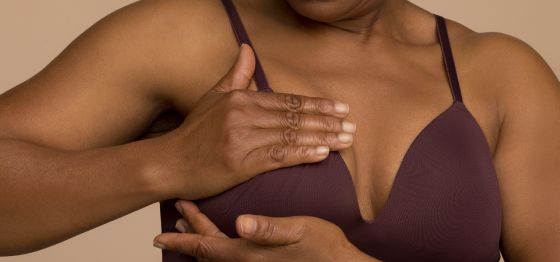Breast cancer is the most frequently diagnosed cancer worldwide and is the most common form of cancer affecting women.1
With the prevalence of the disease, breast cancer research and treatments have progressed. The National Cancer Institute reports that 90.3% of women with breast cancer survive at least 5 years after diagnosis.2 This survival rate includes all women with breast cancer, regardless of the stage. The 5-year survival rate for women diagnosed with localized breast cancer is 99%.3
Breast cancer signs and symptoms
At least once a month, adult women are encouraged to perform breast self-exams as a form of early detection of breast cancer. Through a combination of visual and physical examinations, the patient can check for signs and symptoms of breast cancer. 4
“40% of diagnosed breast cancers are detected by women who feel a lump, so establishing a regular breast self-exam is very important,” says Lillie D. Shockney, Johns Hopkins University Distinguished Service Professor of Breast Cancer.5
3 early warning signs of cancer may include a lump in the breast or armpit, skin changes in the breast and pain in the breast.6
While the most common symptom of breast cancer is a new lump or mass, women are to be aware that most breast lumps are not cancer.7 Patients are advised to pay special attention to any new painless, hard mass that has irregular edges. However, breast cancers may be soft, round, tender or even painful.8
Other signs and symptoms of breast cancer include:9
- Inflammation of all or part of a breast.
- Dimpling skin, similar to an orange peel.
- Pain in the breast or nipple.
- Retraction of the nipple (turning inward).
- Skin on the breast or nipple turning red, dry, flaking or thickened.
- Nipple discharge (other than breast milk).
- Swollen lymph nodes under the arm or near the collar bone.
While some of these symptoms may be caused by benign (non-cancerous) breast conditions, patients are encouraged to have any new breast mass, lump or other change checked by an experienced health care professional.10
Stages of breast cancer
The stage of cancer describes the size of the tumor or abnormal cells and whether those cells have spread to nearby lymph nodes or other organs.11
Cancer can be stage 0, 1, 2, 3 or 4. The lower the number, the less the cancer has spread.12 A higher number, like stage 4, is a more serious cancer that has spread beyond the breast, also called metastatic breast cancer.13
The very first stage of breast cancer, stage 0, is called “carcinoma in situ.” Carcinoma is another word for cancer and “in situ” means “in the original place, meaning the cancer is localized in the breast.”14
Breast cancer risk factors
The main factors that influence breast cancer risk include being a woman and getting older.15 What age does breast cancer start? Most breast cancers are found in women over 50 years old.16
Besides being female and getting older, factors associated with an increased risk of breast cancer include:17
- Patient previously had breast cancer and conditions.
- Family member has/had breast cancer.
- Inherited genes, such as BRCA1 and BRCA2, increase cancer risk.
- Exposure to radiation.
- Obesity.
- Began menstruation at a younger age.
- Began menopause at an older age.
Reducing risks of breast cancer
To reduce the risks of breast cancer, patients can make simple lifestyle changes, such as:18
- Breast self-examination – Monthly breast self-exams may allow women to become familiar with their breasts and more easily recognize changes that may require a doctor visit. However, for women with average risk for breast cancer, the U.S. Preventive Services Task Force found no benefit in self-exams. Instead, the task force recommends women rely on annual mammograms and clinical breast exams by a primary healthcare provider, gynecologist or breast specialist.19
- Breast cancer screening – A patient’s physician will determine whether an annual mammogram or a clinical breast exam is advised.
- Limit alcohol – No more than 1 drink a day.
- Exercise regularly – Physical activity and exercise for at least 30 minutes on most days of the week.
- Minimize postmenopausal hormone therapy – Patients are advised to use the lowest dose of hormone therapy for the shortest amount of time to reduce the risk of breast cancer.
- Healthy weight management – For patients who need to lose weight, reduce caloric intake daily and slowly increase the amount of exercise.
- Eat a healthy diet – The Mayo Clinic advocates a Mediterranean diet focused on plant-based foods, fruits, vegetables, whole grains, legumes and nuts. Healthy fats and fish instead of red meat may reduce the risk of breast cancer.20
For women with a family history of breast cancer, have precancerous conditions or a very high risk of breast cancer, healthcare providers may recommend:21
- Preventive medications (chemoprevention) – Estrogen-blocking medications may minimize development of breast cancer in women with a high risk of the disease. Since these medications may have side effects, doctors reserve these treatments for women with a very high risk of breast cancer.
- Preventive surgery – Women with a very high risk of breast cancer may choose to have their healthy breasts surgically removed (prophylactic mastectomy). They may also choose to have their healthy ovaries removed (prophylactic oophorectomy) to reduce the risk of both breast cancer and ovarian cancer.
Breast cancer treatments
There are many ways to treat breast cancer and doctors often use more than 1 treatment.22
Surgery and radiation are used to treat cancer in a specific part of the body, such as the breast. These treatments don’t affect the rest of the body.23
On the other hand, chemotherapy (chemo), hormone treatment, targeted therapy and immunotherapy drugs can reach cancer cells almost anywhere in the body.24
Depending on the patient’s cancer stage, age, other health conditions and possibilities of side effects, healthcare providers will recommend treatment plans that may include:25
- Surgery for breast cancer
Most women with breast cancer undergo surgery. Typical breast surgeries are lumpectomy, mastectomy and taking out lymph nodes from the underarm. Women who have breast surgery may also decide to have breast reconstruction to rebuild the breast shape, either at the same time or afterwards.
- Radiation treatments
Radiation kills cancer cells by using high-energy rays (like x-rays). This treatment may be used to kill any cancer cells in the breast, chest or armpit after surgery.
- Chemotherapy
Chemotherapy, or chemo, is the use of drugs to fight cancer. Injected into a vein or taken as pills, the drugs go into the blood and spread through most of the body. Chemotherapy may begin before, after, or both before and after surgery. 2 or more chemo drugs are commonly given at a time and treatments often last for many months.
- Hormone therapy
The female hormone estrogen, even in small amounts after menopause, cause some breast cancers to grow. Hormone therapy drugs that block the effect of estrogen or cut down estrogen levels can be used to treat these breast cancers.
Hormone therapy may also be used to help lower the risk of cancer coming back after treatment. Women who have already gone through menopause may be given a drug called an aromatase inhibitor to lower estrogen levels. These pills are taken once a day for 5 to 10 years after surgery. Another drug called tamoxifen can be taken by women who have not gone through menopause.
A patient’s physician may recommend other drugs and other ways to lower estrogen to help treat breast cancer.
- Targeted drug therapy
Targeted therapy drugs may be used for certain types of breast cancer. These drugs help kill cancer cells and rarely affect normal cells in the body.
- Immunotherapy
Immunotherapy is a treatment that boosts the body’s own immune system to attack breast cancer cells. These drugs may be given into a vein or taken as pills.
- Clinical trials
Clinical trials are research studies that test new drugs or other treatments in people. They compare standard treatments with others that may be better.
Clinical trials are one way to get the latest cancer treatments that are being studied. If a patient’s doctor identifies a clinical trial, it’s up to the patient if they want to take part. The patient can also choose to stop participating in the clinical trial at any time.
Support for breast cancer patients
Breast cancer patients can access key resources to support them along their journey to health and healing – when they are diagnosed, begin treatment and move toward recovery.
- American Cancer Society offers a 24/7 cancer hotline with the ability to schedule a video chat, as well as resources to get transportation and lodging during cancer treatments, connecting cancer survivors and more.26
- The BreastCancer.org website includes free resources and answers to frequently asked questions to support those who are: concerned about risk, newly diagnosed, living with metastatic disease, in treatment, finished with treatment or caring for someone.27
- CancerCare provides free, professional support services for people affected by breast cancer, from counseling to financial assistance and support groups.28
Go365 by Humana® makes wellness fun and easy. We help Humana Medicare members with Go365® on their plan reach health goals as well as take care of their physical and emotional health—allowing members to thrive at any age.
Humana Medicare members with Go365 on their plan can activate their Go365 account at
Go365 is a well-being and rewards program for many Humana Medicare Advantage members. Rewards have no cash value and can only be redeemed in the Go365 Mall. Rewards must be earned and redeemed within the same plan year. Any rewards not redeemed by December 31st will be forfeited.
If you need to enroll in Medicare Advantage or change your plan outside of the usual Medicare Annual Election Period, a Special Election Period (SEP) could be the answer. For information on eligibility, visit Humana’s
To learn more about Humana Medicare Advantage, call to speak with a licensed Humana sales agent at 844-321-5843 (TTY: 711), Monday – Friday, 8 a.m. – 8 p.m. local time or visit
Sources:
1Jill Selaid-Schuman, “Breast Cancer Prognosis: Survival Rates by Stage, Age, and Race,” Healthline, last accessed August 15, 2023,
2Selaid-Schuman, “Breast Cancer Prognosis: Survival Rates by Stage, Age, and Race.”
3Selaid-Schuman, “Breast Cancer Prognosis: Survival Rates by Stage, Age, and Race.”
4“Breast Self-Exam,” National Breast Cancer Foundation, last accessed August 15, 2023,
5“Breast Self-Exam.”
6“Breast Cancer Signs and Symptoms,” WebMD, last accessed August 15, 2023,
7“Breast Cancer Signs and Symptoms,” American Cancer Society, last accessed August 15, 2023,
8“Breast Cancer Signs and Symptoms,” American Cancer Society
9“Breast Cancer Signs and Symptoms,” American Cancer Society.
10“Breast Cancer Signs and Symptoms,” American Cancer Society.
11“If You Have Breast Cancer,” American Cancer Society, last accessed August 15, 2023,
12“If You Have Breast Cancer.”
13“If You Have Breast Cancer.”
14“Stages 0 & 1 Breast Cancer Overview,” National Breast Cancer Foundation, last accessed August 15, 2023,
15“What Are the Risk Factors for Breast Cancer?” Centers for Disease Control and Prevention, last accessed August 15, 2023,
16“What Are the Risk Factors for Breast Cancer?”
17“Breast cancer,” Mayo Clinic, last accessed August 15, 2023,
18“Breast cancer,” Mayo Clinic.
19“Examining the Bare Truth About Breast Self-Exams,” Cedars Sinai, last accessed August 29, 2023,
20“Breast cancer,” Mayo Clinic.
21“Breast cancer,” Mayo Clinic.
22“If You Have Breast Cancer.”
23“If You Have Breast Cancer.”
24“If You Have Breast Cancer.”
25“If You Have Breast Cancer.”
26“ACS Patient Program and Services,” American Cancer Society, last accessed August 15, 2023,
27“Trusted guidance when you need us most,” BreastCancer.org, last accessed August 15, 2023,
28“Breast Cancer,” CancerCare, last accessed August 15, 2023,
This information is provided for educational purposes only. It is not to be used for medical advice, diagnosis or treatment. Consult your healthcare provider if you have questions or concerns.
Humana is a Medicare Advantage HMO, PPO and PFFS organization and a stand-alone prescription drug plan with a Medicare contract. Humana is also a Coordinated Care plan with a Medicare contract and a contract with the state Medicaid program. Enrollment in any Humana plan depends on contract renewal.





)
